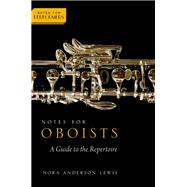Notes for Oboists A Guide to the Repertoire
, by Lewis, Nora Anderson- ISBN: 9780197546550 | 0197546552
- Cover: Paperback
- Copyright: 3/3/2025
Notes for Oboists: A Guide to the Repertoire is an essential resource for professional, amateur, and student oboists that collects the important historical and analytical information for thirty-five of the best-known pieces composed for the instrument. These works span the eighteenth through the twenty-first century and include sonatas, concertos, chamber music, and works for solo oboe by a wide range of composers. Chapters will cover compositions such as Alessandro Marcello's Concerto in D Minor, Robert Schumann's Three Romances Op. 94, Francis Poulenc's Sonata for Oboe and Piano, Isang Yun's Piri for Oboe Solo, Reena Esmail's Jhula Jhule for Oboe and Piano, and thirty other treasures of the oboe repertoire.
Writing in engaging and accessible prose supported by fact-filled analytical charts, Nora A. Lewis offers rich biographical information on individual composers, historical context for compositions (such as the circumstances for its development), as well as clear structural analyses to help oboists gain a deeper understanding of well-known repertoire. In offering both historical/biographical as well as musicological insight, Notes for Oboists connects performance studies with scholarship, allowing readers to build a more complete picture of the music and encourage them to approach other compositions in a similarly analytical manner.
Writing in engaging and accessible prose supported by fact-filled analytical charts, Nora A. Lewis offers rich biographical information on individual composers, historical context for compositions (such as the circumstances for its development), as well as clear structural analyses to help oboists gain a deeper understanding of well-known repertoire. In offering both historical/biographical as well as musicological insight, Notes for Oboists connects performance studies with scholarship, allowing readers to build a more complete picture of the music and encourage them to approach other compositions in a similarly analytical manner.






